HI6028 Taxation Law T1 2018: Income Assessment - Case Analysis
VerifiedAdded on 2023/06/12
|14
|3430
|287
Case Study
AI Summary
This case study provides a detailed analysis of taxation law principles, specifically focusing on income assessment through the examination of Arthur Murray (NSW) Pty Ltd and RIP Pty Ltd cases. The analysis covers the interpretation of the Income Tax Assessment Act 1997, including sections related to assessable income and the earning versus receipt methods of income calculation. It explores the complexities of prepaid tuition fees in the Arthur Murray case and the revenue recognition practices of RIP Pty Ltd, a funeral service company. The study also compares the income assessment methods applied in both cases, highlighting the importance of aligning accounting practices with taxation regulations. The document concludes by discussing various income assessment sections, emphasizing the discretionary power of the Tax Commissioner in determining the appropriate method for assessing taxable income. Desklib offers a platform to access more such solved assignments and study resources for students.
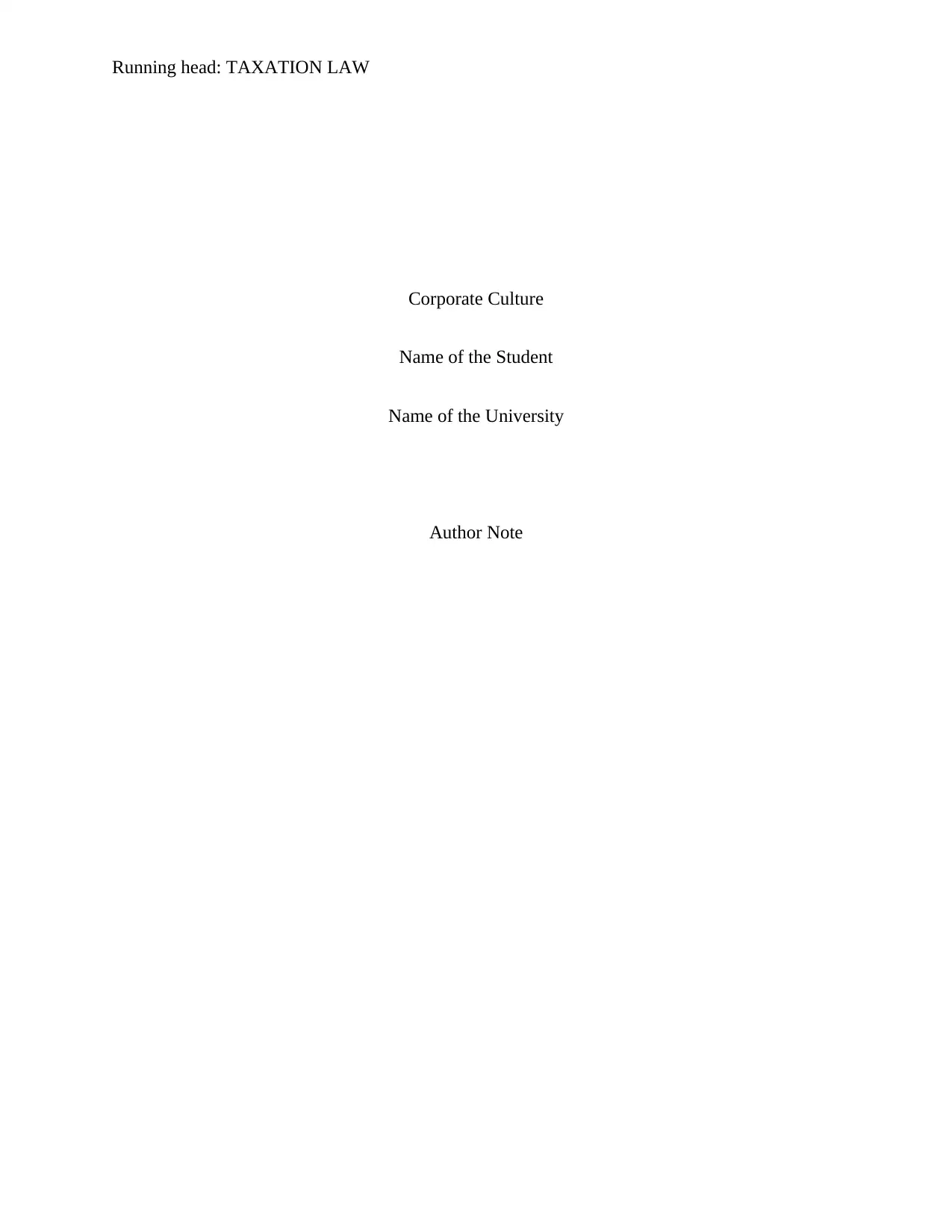
Running head: TAXATION LAW
Corporate Culture
Name of the Student
Name of the University
Author Note
Corporate Culture
Name of the Student
Name of the University
Author Note
Paraphrase This Document
Need a fresh take? Get an instant paraphrase of this document with our AI Paraphraser
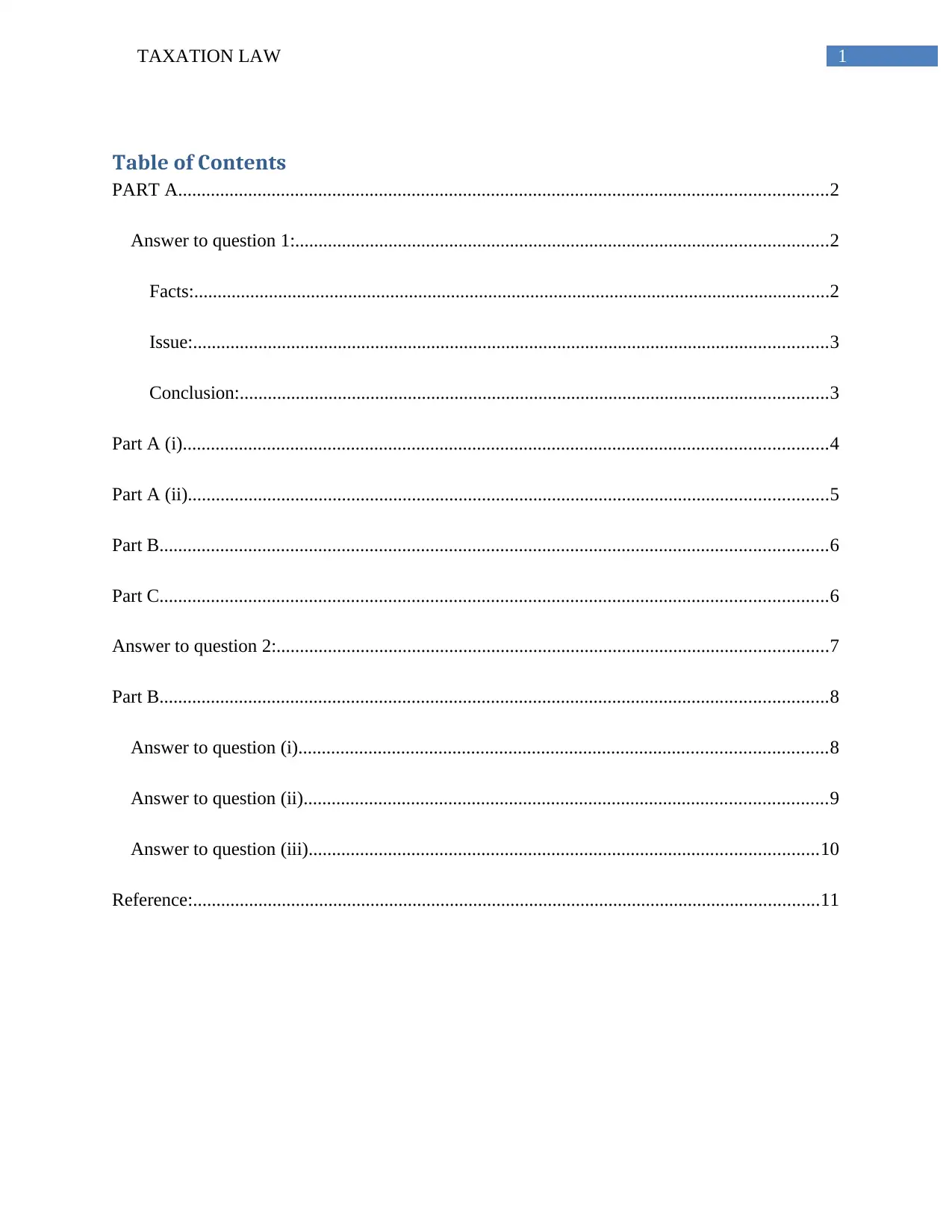
1TAXATION LAW
Table of Contents
PART A...........................................................................................................................................2
Answer to question 1:..................................................................................................................2
Facts:........................................................................................................................................2
Issue:........................................................................................................................................3
Conclusion:..............................................................................................................................3
Part A (i)..........................................................................................................................................4
Part A (ii).........................................................................................................................................5
Part B...............................................................................................................................................6
Part C...............................................................................................................................................6
Answer to question 2:......................................................................................................................7
Part B...............................................................................................................................................8
Answer to question (i).................................................................................................................8
Answer to question (ii)................................................................................................................9
Answer to question (iii).............................................................................................................10
Reference:......................................................................................................................................11
Table of Contents
PART A...........................................................................................................................................2
Answer to question 1:..................................................................................................................2
Facts:........................................................................................................................................2
Issue:........................................................................................................................................3
Conclusion:..............................................................................................................................3
Part A (i)..........................................................................................................................................4
Part A (ii).........................................................................................................................................5
Part B...............................................................................................................................................6
Part C...............................................................................................................................................6
Answer to question 2:......................................................................................................................7
Part B...............................................................................................................................................8
Answer to question (i).................................................................................................................8
Answer to question (ii)................................................................................................................9
Answer to question (iii).............................................................................................................10
Reference:......................................................................................................................................11
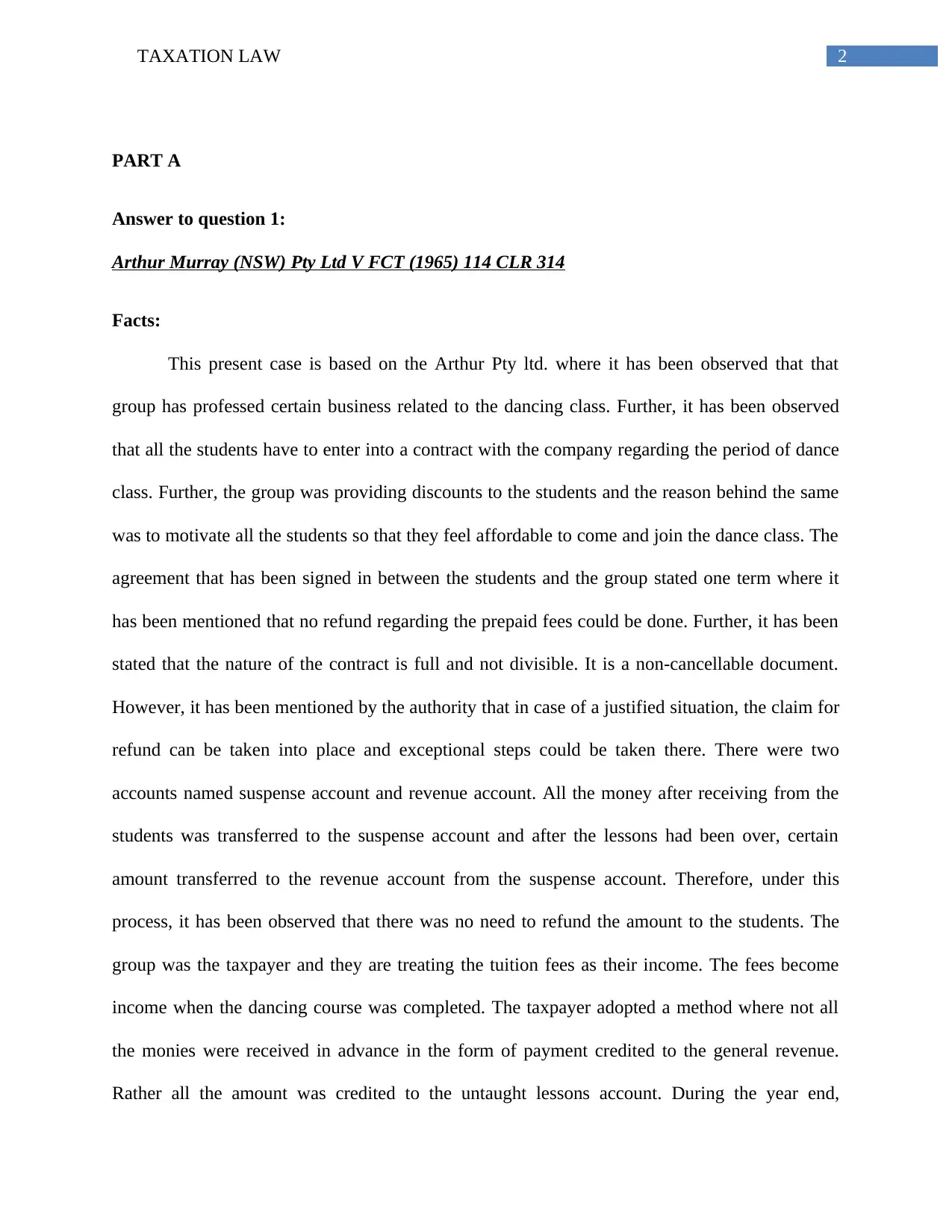
2TAXATION LAW
PART A
Answer to question 1:
Arthur Murray (NSW) Pty Ltd V FCT (1965) 114 CLR 314
Facts:
This present case is based on the Arthur Pty ltd. where it has been observed that that
group has professed certain business related to the dancing class. Further, it has been observed
that all the students have to enter into a contract with the company regarding the period of dance
class. Further, the group was providing discounts to the students and the reason behind the same
was to motivate all the students so that they feel affordable to come and join the dance class. The
agreement that has been signed in between the students and the group stated one term where it
has been mentioned that no refund regarding the prepaid fees could be done. Further, it has been
stated that the nature of the contract is full and not divisible. It is a non-cancellable document.
However, it has been mentioned by the authority that in case of a justified situation, the claim for
refund can be taken into place and exceptional steps could be taken there. There were two
accounts named suspense account and revenue account. All the money after receiving from the
students was transferred to the suspense account and after the lessons had been over, certain
amount transferred to the revenue account from the suspense account. Therefore, under this
process, it has been observed that there was no need to refund the amount to the students. The
group was the taxpayer and they are treating the tuition fees as their income. The fees become
income when the dancing course was completed. The taxpayer adopted a method where not all
the monies were received in advance in the form of payment credited to the general revenue.
Rather all the amount was credited to the untaught lessons account. During the year end,
PART A
Answer to question 1:
Arthur Murray (NSW) Pty Ltd V FCT (1965) 114 CLR 314
Facts:
This present case is based on the Arthur Pty ltd. where it has been observed that that
group has professed certain business related to the dancing class. Further, it has been observed
that all the students have to enter into a contract with the company regarding the period of dance
class. Further, the group was providing discounts to the students and the reason behind the same
was to motivate all the students so that they feel affordable to come and join the dance class. The
agreement that has been signed in between the students and the group stated one term where it
has been mentioned that no refund regarding the prepaid fees could be done. Further, it has been
stated that the nature of the contract is full and not divisible. It is a non-cancellable document.
However, it has been mentioned by the authority that in case of a justified situation, the claim for
refund can be taken into place and exceptional steps could be taken there. There were two
accounts named suspense account and revenue account. All the money after receiving from the
students was transferred to the suspense account and after the lessons had been over, certain
amount transferred to the revenue account from the suspense account. Therefore, under this
process, it has been observed that there was no need to refund the amount to the students. The
group was the taxpayer and they are treating the tuition fees as their income. The fees become
income when the dancing course was completed. The taxpayer adopted a method where not all
the monies were received in advance in the form of payment credited to the general revenue.
Rather all the amount was credited to the untaught lessons account. During the year end,
⊘ This is a preview!⊘
Do you want full access?
Subscribe today to unlock all pages.

Trusted by 1+ million students worldwide
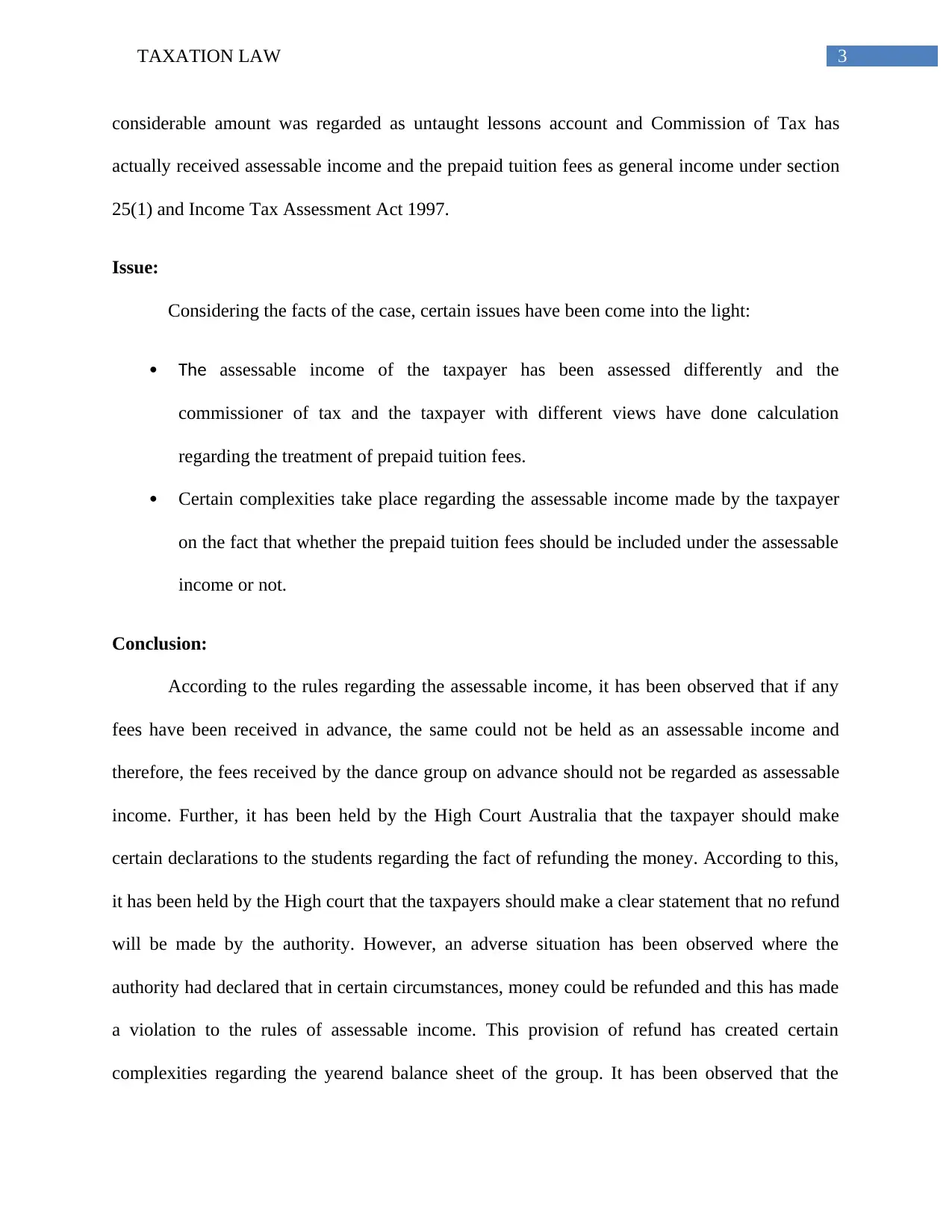
3TAXATION LAW
considerable amount was regarded as untaught lessons account and Commission of Tax has
actually received assessable income and the prepaid tuition fees as general income under section
25(1) and Income Tax Assessment Act 1997.
Issue:
Considering the facts of the case, certain issues have been come into the light:
The assessable income of the taxpayer has been assessed differently and the
commissioner of tax and the taxpayer with different views have done calculation
regarding the treatment of prepaid tuition fees.
Certain complexities take place regarding the assessable income made by the taxpayer
on the fact that whether the prepaid tuition fees should be included under the assessable
income or not.
Conclusion:
According to the rules regarding the assessable income, it has been observed that if any
fees have been received in advance, the same could not be held as an assessable income and
therefore, the fees received by the dance group on advance should not be regarded as assessable
income. Further, it has been held by the High Court Australia that the taxpayer should make
certain declarations to the students regarding the fact of refunding the money. According to this,
it has been held by the High court that the taxpayers should make a clear statement that no refund
will be made by the authority. However, an adverse situation has been observed where the
authority had declared that in certain circumstances, money could be refunded and this has made
a violation to the rules of assessable income. This provision of refund has created certain
complexities regarding the yearend balance sheet of the group. It has been observed that the
considerable amount was regarded as untaught lessons account and Commission of Tax has
actually received assessable income and the prepaid tuition fees as general income under section
25(1) and Income Tax Assessment Act 1997.
Issue:
Considering the facts of the case, certain issues have been come into the light:
The assessable income of the taxpayer has been assessed differently and the
commissioner of tax and the taxpayer with different views have done calculation
regarding the treatment of prepaid tuition fees.
Certain complexities take place regarding the assessable income made by the taxpayer
on the fact that whether the prepaid tuition fees should be included under the assessable
income or not.
Conclusion:
According to the rules regarding the assessable income, it has been observed that if any
fees have been received in advance, the same could not be held as an assessable income and
therefore, the fees received by the dance group on advance should not be regarded as assessable
income. Further, it has been held by the High Court Australia that the taxpayer should make
certain declarations to the students regarding the fact of refunding the money. According to this,
it has been held by the High court that the taxpayers should make a clear statement that no refund
will be made by the authority. However, an adverse situation has been observed where the
authority had declared that in certain circumstances, money could be refunded and this has made
a violation to the rules of assessable income. This provision of refund has created certain
complexities regarding the yearend balance sheet of the group. It has been observed that the
Paraphrase This Document
Need a fresh take? Get an instant paraphrase of this document with our AI Paraphraser
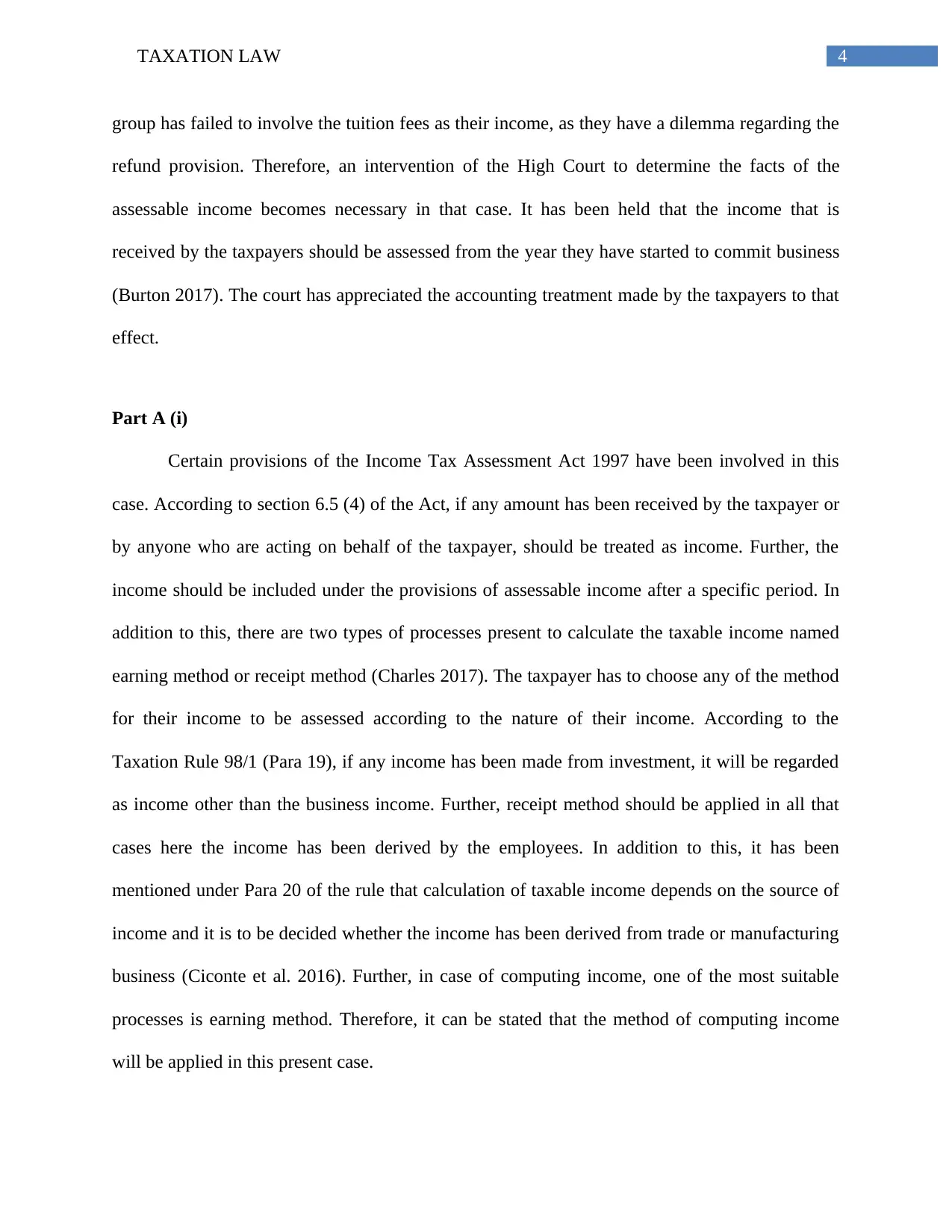
4TAXATION LAW
group has failed to involve the tuition fees as their income, as they have a dilemma regarding the
refund provision. Therefore, an intervention of the High Court to determine the facts of the
assessable income becomes necessary in that case. It has been held that the income that is
received by the taxpayers should be assessed from the year they have started to commit business
(Burton 2017). The court has appreciated the accounting treatment made by the taxpayers to that
effect.
Part A (i)
Certain provisions of the Income Tax Assessment Act 1997 have been involved in this
case. According to section 6.5 (4) of the Act, if any amount has been received by the taxpayer or
by anyone who are acting on behalf of the taxpayer, should be treated as income. Further, the
income should be included under the provisions of assessable income after a specific period. In
addition to this, there are two types of processes present to calculate the taxable income named
earning method or receipt method (Charles 2017). The taxpayer has to choose any of the method
for their income to be assessed according to the nature of their income. According to the
Taxation Rule 98/1 (Para 19), if any income has been made from investment, it will be regarded
as income other than the business income. Further, receipt method should be applied in all that
cases here the income has been derived by the employees. In addition to this, it has been
mentioned under Para 20 of the rule that calculation of taxable income depends on the source of
income and it is to be decided whether the income has been derived from trade or manufacturing
business (Ciconte et al. 2016). Further, in case of computing income, one of the most suitable
processes is earning method. Therefore, it can be stated that the method of computing income
will be applied in this present case.
group has failed to involve the tuition fees as their income, as they have a dilemma regarding the
refund provision. Therefore, an intervention of the High Court to determine the facts of the
assessable income becomes necessary in that case. It has been held that the income that is
received by the taxpayers should be assessed from the year they have started to commit business
(Burton 2017). The court has appreciated the accounting treatment made by the taxpayers to that
effect.
Part A (i)
Certain provisions of the Income Tax Assessment Act 1997 have been involved in this
case. According to section 6.5 (4) of the Act, if any amount has been received by the taxpayer or
by anyone who are acting on behalf of the taxpayer, should be treated as income. Further, the
income should be included under the provisions of assessable income after a specific period. In
addition to this, there are two types of processes present to calculate the taxable income named
earning method or receipt method (Charles 2017). The taxpayer has to choose any of the method
for their income to be assessed according to the nature of their income. According to the
Taxation Rule 98/1 (Para 19), if any income has been made from investment, it will be regarded
as income other than the business income. Further, receipt method should be applied in all that
cases here the income has been derived by the employees. In addition to this, it has been
mentioned under Para 20 of the rule that calculation of taxable income depends on the source of
income and it is to be decided whether the income has been derived from trade or manufacturing
business (Ciconte et al. 2016). Further, in case of computing income, one of the most suitable
processes is earning method. Therefore, it can be stated that the method of computing income
will be applied in this present case.
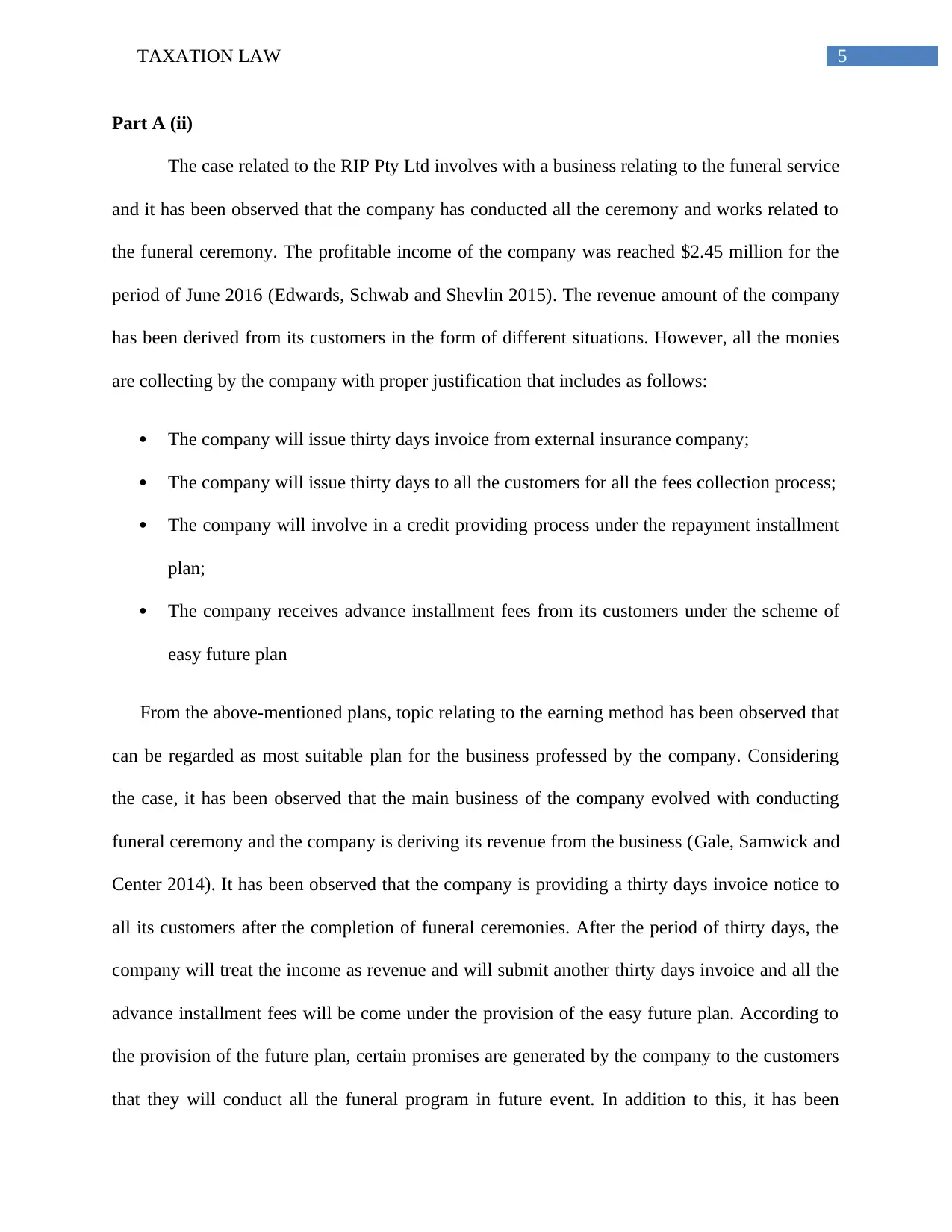
5TAXATION LAW
Part A (ii)
The case related to the RIP Pty Ltd involves with a business relating to the funeral service
and it has been observed that the company has conducted all the ceremony and works related to
the funeral ceremony. The profitable income of the company was reached $2.45 million for the
period of June 2016 (Edwards, Schwab and Shevlin 2015). The revenue amount of the company
has been derived from its customers in the form of different situations. However, all the monies
are collecting by the company with proper justification that includes as follows:
The company will issue thirty days invoice from external insurance company;
The company will issue thirty days to all the customers for all the fees collection process;
The company will involve in a credit providing process under the repayment installment
plan;
The company receives advance installment fees from its customers under the scheme of
easy future plan
From the above-mentioned plans, topic relating to the earning method has been observed that
can be regarded as most suitable plan for the business professed by the company. Considering
the case, it has been observed that the main business of the company evolved with conducting
funeral ceremony and the company is deriving its revenue from the business (Gale, Samwick and
Center 2014). It has been observed that the company is providing a thirty days invoice notice to
all its customers after the completion of funeral ceremonies. After the period of thirty days, the
company will treat the income as revenue and will submit another thirty days invoice and all the
advance installment fees will be come under the provision of the easy future plan. According to
the provision of the future plan, certain promises are generated by the company to the customers
that they will conduct all the funeral program in future event. In addition to this, it has been
Part A (ii)
The case related to the RIP Pty Ltd involves with a business relating to the funeral service
and it has been observed that the company has conducted all the ceremony and works related to
the funeral ceremony. The profitable income of the company was reached $2.45 million for the
period of June 2016 (Edwards, Schwab and Shevlin 2015). The revenue amount of the company
has been derived from its customers in the form of different situations. However, all the monies
are collecting by the company with proper justification that includes as follows:
The company will issue thirty days invoice from external insurance company;
The company will issue thirty days to all the customers for all the fees collection process;
The company will involve in a credit providing process under the repayment installment
plan;
The company receives advance installment fees from its customers under the scheme of
easy future plan
From the above-mentioned plans, topic relating to the earning method has been observed that
can be regarded as most suitable plan for the business professed by the company. Considering
the case, it has been observed that the main business of the company evolved with conducting
funeral ceremony and the company is deriving its revenue from the business (Gale, Samwick and
Center 2014). It has been observed that the company is providing a thirty days invoice notice to
all its customers after the completion of funeral ceremonies. After the period of thirty days, the
company will treat the income as revenue and will submit another thirty days invoice and all the
advance installment fees will be come under the provision of the easy future plan. According to
the provision of the future plan, certain promises are generated by the company to the customers
that they will conduct all the funeral program in future event. In addition to this, it has been
⊘ This is a preview!⊘
Do you want full access?
Subscribe today to unlock all pages.

Trusted by 1+ million students worldwide
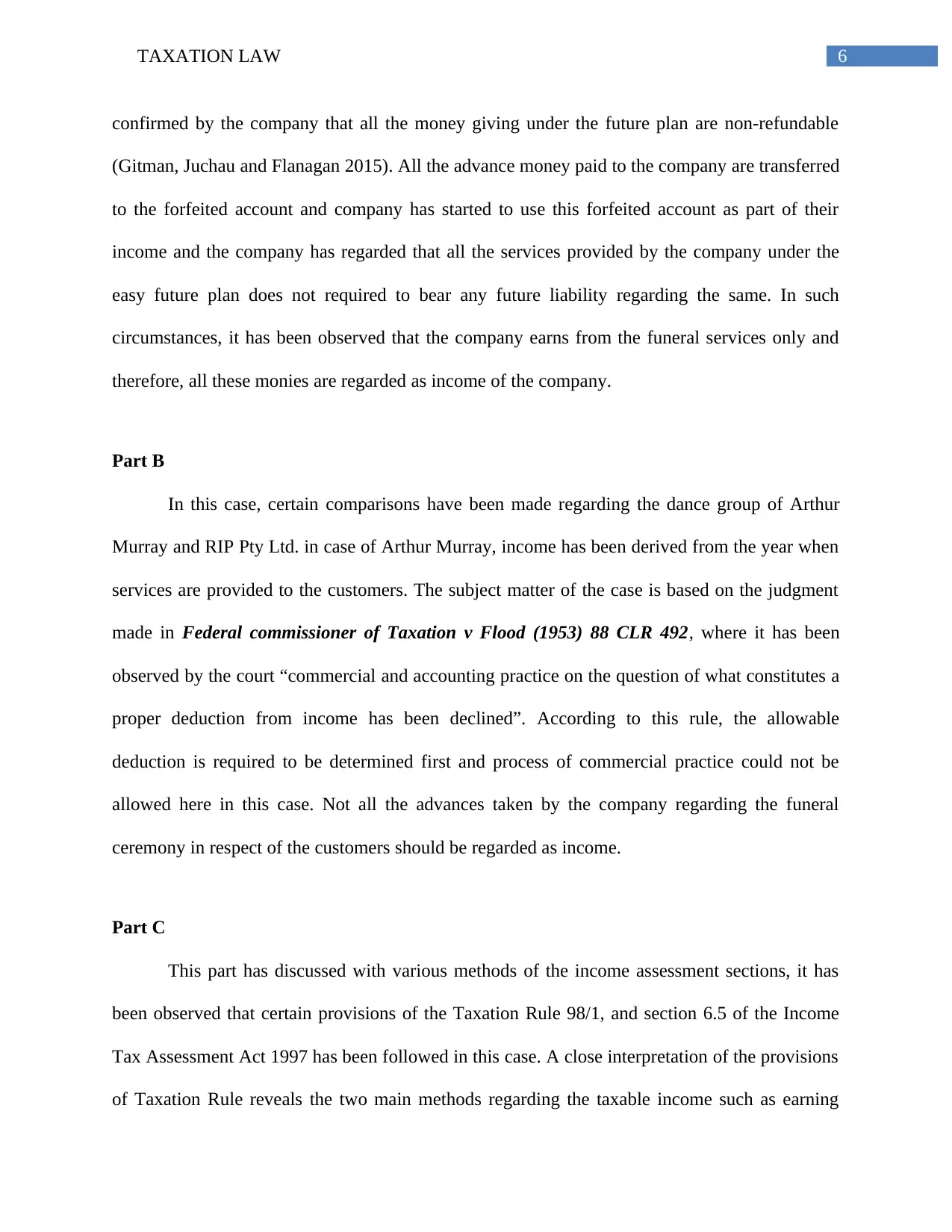
6TAXATION LAW
confirmed by the company that all the money giving under the future plan are non-refundable
(Gitman, Juchau and Flanagan 2015). All the advance money paid to the company are transferred
to the forfeited account and company has started to use this forfeited account as part of their
income and the company has regarded that all the services provided by the company under the
easy future plan does not required to bear any future liability regarding the same. In such
circumstances, it has been observed that the company earns from the funeral services only and
therefore, all these monies are regarded as income of the company.
Part B
In this case, certain comparisons have been made regarding the dance group of Arthur
Murray and RIP Pty Ltd. in case of Arthur Murray, income has been derived from the year when
services are provided to the customers. The subject matter of the case is based on the judgment
made in Federal commissioner of Taxation v Flood (1953) 88 CLR 492, where it has been
observed by the court “commercial and accounting practice on the question of what constitutes a
proper deduction from income has been declined”. According to this rule, the allowable
deduction is required to be determined first and process of commercial practice could not be
allowed here in this case. Not all the advances taken by the company regarding the funeral
ceremony in respect of the customers should be regarded as income.
Part C
This part has discussed with various methods of the income assessment sections, it has
been observed that certain provisions of the Taxation Rule 98/1, and section 6.5 of the Income
Tax Assessment Act 1997 has been followed in this case. A close interpretation of the provisions
of Taxation Rule reveals the two main methods regarding the taxable income such as earning
confirmed by the company that all the money giving under the future plan are non-refundable
(Gitman, Juchau and Flanagan 2015). All the advance money paid to the company are transferred
to the forfeited account and company has started to use this forfeited account as part of their
income and the company has regarded that all the services provided by the company under the
easy future plan does not required to bear any future liability regarding the same. In such
circumstances, it has been observed that the company earns from the funeral services only and
therefore, all these monies are regarded as income of the company.
Part B
In this case, certain comparisons have been made regarding the dance group of Arthur
Murray and RIP Pty Ltd. in case of Arthur Murray, income has been derived from the year when
services are provided to the customers. The subject matter of the case is based on the judgment
made in Federal commissioner of Taxation v Flood (1953) 88 CLR 492, where it has been
observed by the court “commercial and accounting practice on the question of what constitutes a
proper deduction from income has been declined”. According to this rule, the allowable
deduction is required to be determined first and process of commercial practice could not be
allowed here in this case. Not all the advances taken by the company regarding the funeral
ceremony in respect of the customers should be regarded as income.
Part C
This part has discussed with various methods of the income assessment sections, it has
been observed that certain provisions of the Taxation Rule 98/1, and section 6.5 of the Income
Tax Assessment Act 1997 has been followed in this case. A close interpretation of the provisions
of Taxation Rule reveals the two main methods regarding the taxable income such as earning
Paraphrase This Document
Need a fresh take? Get an instant paraphrase of this document with our AI Paraphraser
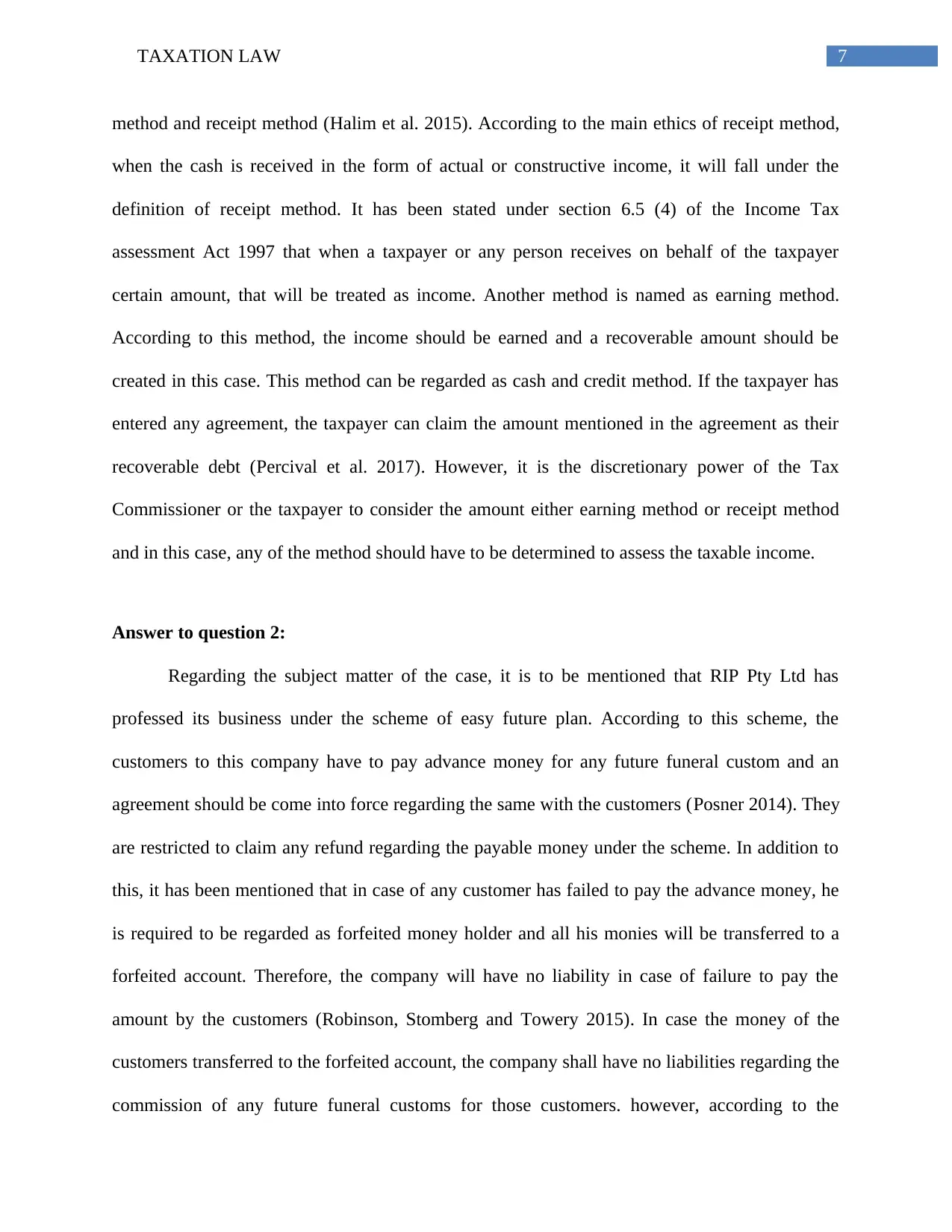
7TAXATION LAW
method and receipt method (Halim et al. 2015). According to the main ethics of receipt method,
when the cash is received in the form of actual or constructive income, it will fall under the
definition of receipt method. It has been stated under section 6.5 (4) of the Income Tax
assessment Act 1997 that when a taxpayer or any person receives on behalf of the taxpayer
certain amount, that will be treated as income. Another method is named as earning method.
According to this method, the income should be earned and a recoverable amount should be
created in this case. This method can be regarded as cash and credit method. If the taxpayer has
entered any agreement, the taxpayer can claim the amount mentioned in the agreement as their
recoverable debt (Percival et al. 2017). However, it is the discretionary power of the Tax
Commissioner or the taxpayer to consider the amount either earning method or receipt method
and in this case, any of the method should have to be determined to assess the taxable income.
Answer to question 2:
Regarding the subject matter of the case, it is to be mentioned that RIP Pty Ltd has
professed its business under the scheme of easy future plan. According to this scheme, the
customers to this company have to pay advance money for any future funeral custom and an
agreement should be come into force regarding the same with the customers (Posner 2014). They
are restricted to claim any refund regarding the payable money under the scheme. In addition to
this, it has been mentioned that in case of any customer has failed to pay the advance money, he
is required to be regarded as forfeited money holder and all his monies will be transferred to a
forfeited account. Therefore, the company will have no liability in case of failure to pay the
amount by the customers (Robinson, Stomberg and Towery 2015). In case the money of the
customers transferred to the forfeited account, the company shall have no liabilities regarding the
commission of any future funeral customs for those customers. however, according to the
method and receipt method (Halim et al. 2015). According to the main ethics of receipt method,
when the cash is received in the form of actual or constructive income, it will fall under the
definition of receipt method. It has been stated under section 6.5 (4) of the Income Tax
assessment Act 1997 that when a taxpayer or any person receives on behalf of the taxpayer
certain amount, that will be treated as income. Another method is named as earning method.
According to this method, the income should be earned and a recoverable amount should be
created in this case. This method can be regarded as cash and credit method. If the taxpayer has
entered any agreement, the taxpayer can claim the amount mentioned in the agreement as their
recoverable debt (Percival et al. 2017). However, it is the discretionary power of the Tax
Commissioner or the taxpayer to consider the amount either earning method or receipt method
and in this case, any of the method should have to be determined to assess the taxable income.
Answer to question 2:
Regarding the subject matter of the case, it is to be mentioned that RIP Pty Ltd has
professed its business under the scheme of easy future plan. According to this scheme, the
customers to this company have to pay advance money for any future funeral custom and an
agreement should be come into force regarding the same with the customers (Posner 2014). They
are restricted to claim any refund regarding the payable money under the scheme. In addition to
this, it has been mentioned that in case of any customer has failed to pay the advance money, he
is required to be regarded as forfeited money holder and all his monies will be transferred to a
forfeited account. Therefore, the company will have no liability in case of failure to pay the
amount by the customers (Robinson, Stomberg and Towery 2015). In case the money of the
customers transferred to the forfeited account, the company shall have no liabilities regarding the
commission of any future funeral customs for those customers. however, according to the
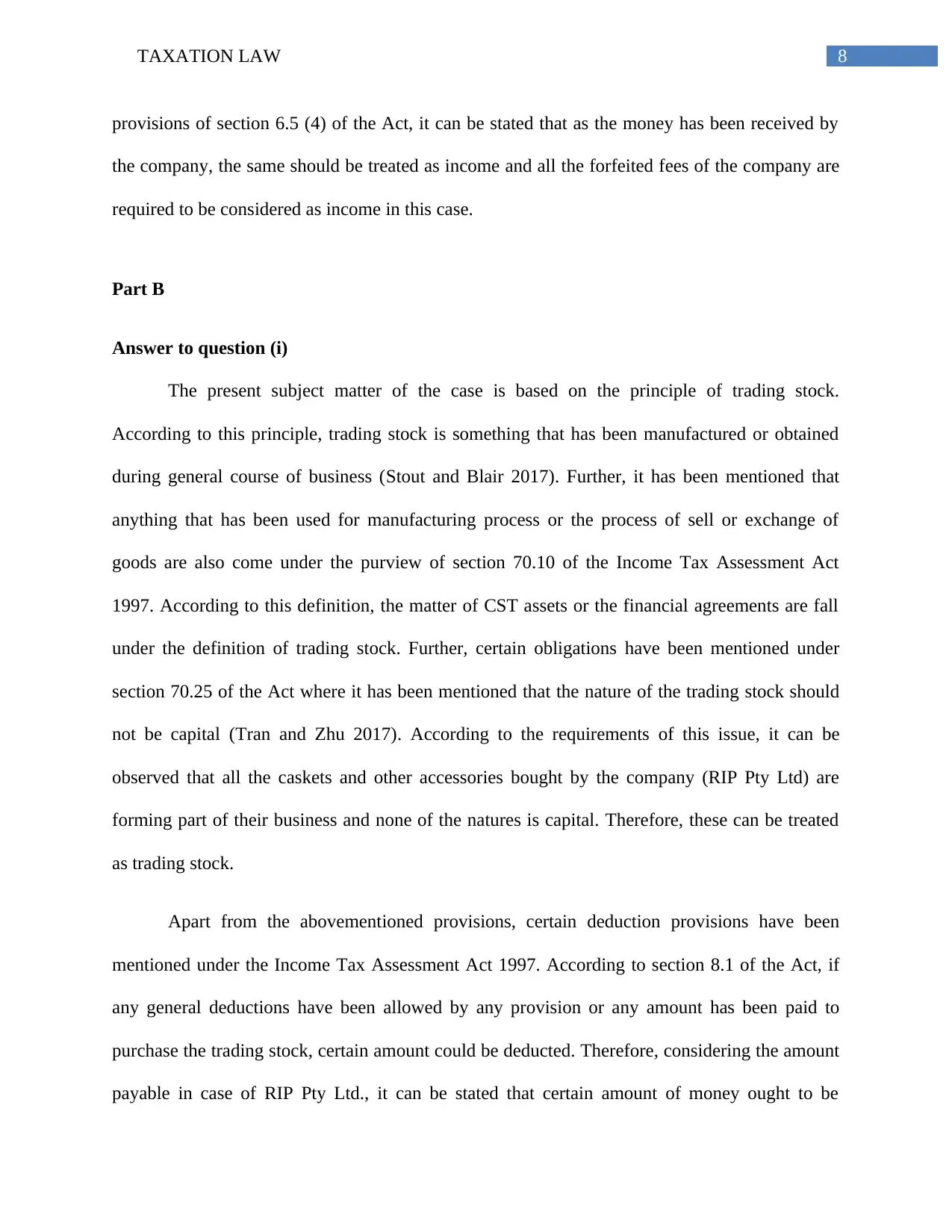
8TAXATION LAW
provisions of section 6.5 (4) of the Act, it can be stated that as the money has been received by
the company, the same should be treated as income and all the forfeited fees of the company are
required to be considered as income in this case.
Part B
Answer to question (i)
The present subject matter of the case is based on the principle of trading stock.
According to this principle, trading stock is something that has been manufactured or obtained
during general course of business (Stout and Blair 2017). Further, it has been mentioned that
anything that has been used for manufacturing process or the process of sell or exchange of
goods are also come under the purview of section 70.10 of the Income Tax Assessment Act
1997. According to this definition, the matter of CST assets or the financial agreements are fall
under the definition of trading stock. Further, certain obligations have been mentioned under
section 70.25 of the Act where it has been mentioned that the nature of the trading stock should
not be capital (Tran and Zhu 2017). According to the requirements of this issue, it can be
observed that all the caskets and other accessories bought by the company (RIP Pty Ltd) are
forming part of their business and none of the natures is capital. Therefore, these can be treated
as trading stock.
Apart from the abovementioned provisions, certain deduction provisions have been
mentioned under the Income Tax Assessment Act 1997. According to section 8.1 of the Act, if
any general deductions have been allowed by any provision or any amount has been paid to
purchase the trading stock, certain amount could be deducted. Therefore, considering the amount
payable in case of RIP Pty Ltd., it can be stated that certain amount of money ought to be
provisions of section 6.5 (4) of the Act, it can be stated that as the money has been received by
the company, the same should be treated as income and all the forfeited fees of the company are
required to be considered as income in this case.
Part B
Answer to question (i)
The present subject matter of the case is based on the principle of trading stock.
According to this principle, trading stock is something that has been manufactured or obtained
during general course of business (Stout and Blair 2017). Further, it has been mentioned that
anything that has been used for manufacturing process or the process of sell or exchange of
goods are also come under the purview of section 70.10 of the Income Tax Assessment Act
1997. According to this definition, the matter of CST assets or the financial agreements are fall
under the definition of trading stock. Further, certain obligations have been mentioned under
section 70.25 of the Act where it has been mentioned that the nature of the trading stock should
not be capital (Tran and Zhu 2017). According to the requirements of this issue, it can be
observed that all the caskets and other accessories bought by the company (RIP Pty Ltd) are
forming part of their business and none of the natures is capital. Therefore, these can be treated
as trading stock.
Apart from the abovementioned provisions, certain deduction provisions have been
mentioned under the Income Tax Assessment Act 1997. According to section 8.1 of the Act, if
any general deductions have been allowed by any provision or any amount has been paid to
purchase the trading stock, certain amount could be deducted. Therefore, considering the amount
payable in case of RIP Pty Ltd., it can be stated that certain amount of money ought to be
⊘ This is a preview!⊘
Do you want full access?
Subscribe today to unlock all pages.

Trusted by 1+ million students worldwide
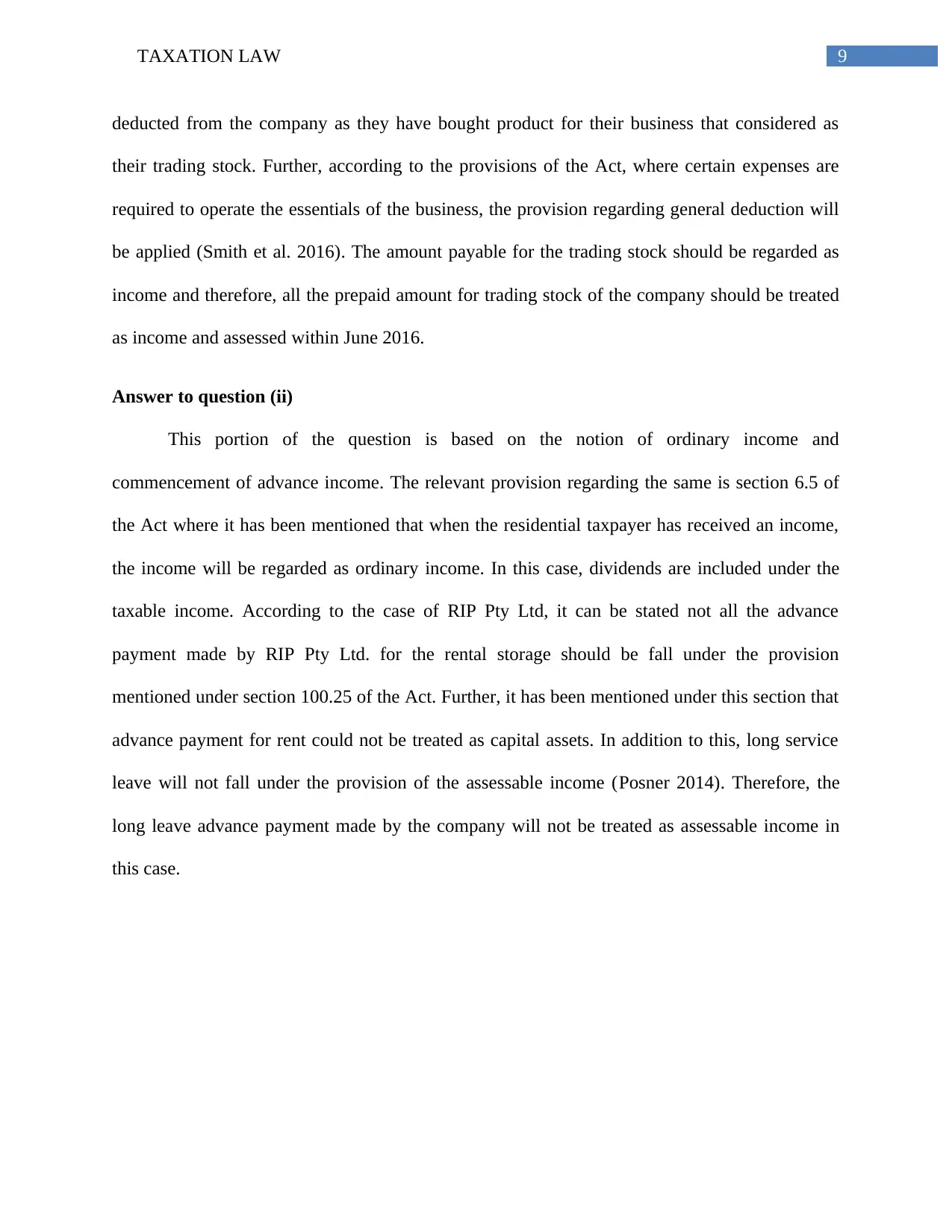
9TAXATION LAW
deducted from the company as they have bought product for their business that considered as
their trading stock. Further, according to the provisions of the Act, where certain expenses are
required to operate the essentials of the business, the provision regarding general deduction will
be applied (Smith et al. 2016). The amount payable for the trading stock should be regarded as
income and therefore, all the prepaid amount for trading stock of the company should be treated
as income and assessed within June 2016.
Answer to question (ii)
This portion of the question is based on the notion of ordinary income and
commencement of advance income. The relevant provision regarding the same is section 6.5 of
the Act where it has been mentioned that when the residential taxpayer has received an income,
the income will be regarded as ordinary income. In this case, dividends are included under the
taxable income. According to the case of RIP Pty Ltd, it can be stated not all the advance
payment made by RIP Pty Ltd. for the rental storage should be fall under the provision
mentioned under section 100.25 of the Act. Further, it has been mentioned under this section that
advance payment for rent could not be treated as capital assets. In addition to this, long service
leave will not fall under the provision of the assessable income (Posner 2014). Therefore, the
long leave advance payment made by the company will not be treated as assessable income in
this case.
deducted from the company as they have bought product for their business that considered as
their trading stock. Further, according to the provisions of the Act, where certain expenses are
required to operate the essentials of the business, the provision regarding general deduction will
be applied (Smith et al. 2016). The amount payable for the trading stock should be regarded as
income and therefore, all the prepaid amount for trading stock of the company should be treated
as income and assessed within June 2016.
Answer to question (ii)
This portion of the question is based on the notion of ordinary income and
commencement of advance income. The relevant provision regarding the same is section 6.5 of
the Act where it has been mentioned that when the residential taxpayer has received an income,
the income will be regarded as ordinary income. In this case, dividends are included under the
taxable income. According to the case of RIP Pty Ltd, it can be stated not all the advance
payment made by RIP Pty Ltd. for the rental storage should be fall under the provision
mentioned under section 100.25 of the Act. Further, it has been mentioned under this section that
advance payment for rent could not be treated as capital assets. In addition to this, long service
leave will not fall under the provision of the assessable income (Posner 2014). Therefore, the
long leave advance payment made by the company will not be treated as assessable income in
this case.
Paraphrase This Document
Need a fresh take? Get an instant paraphrase of this document with our AI Paraphraser
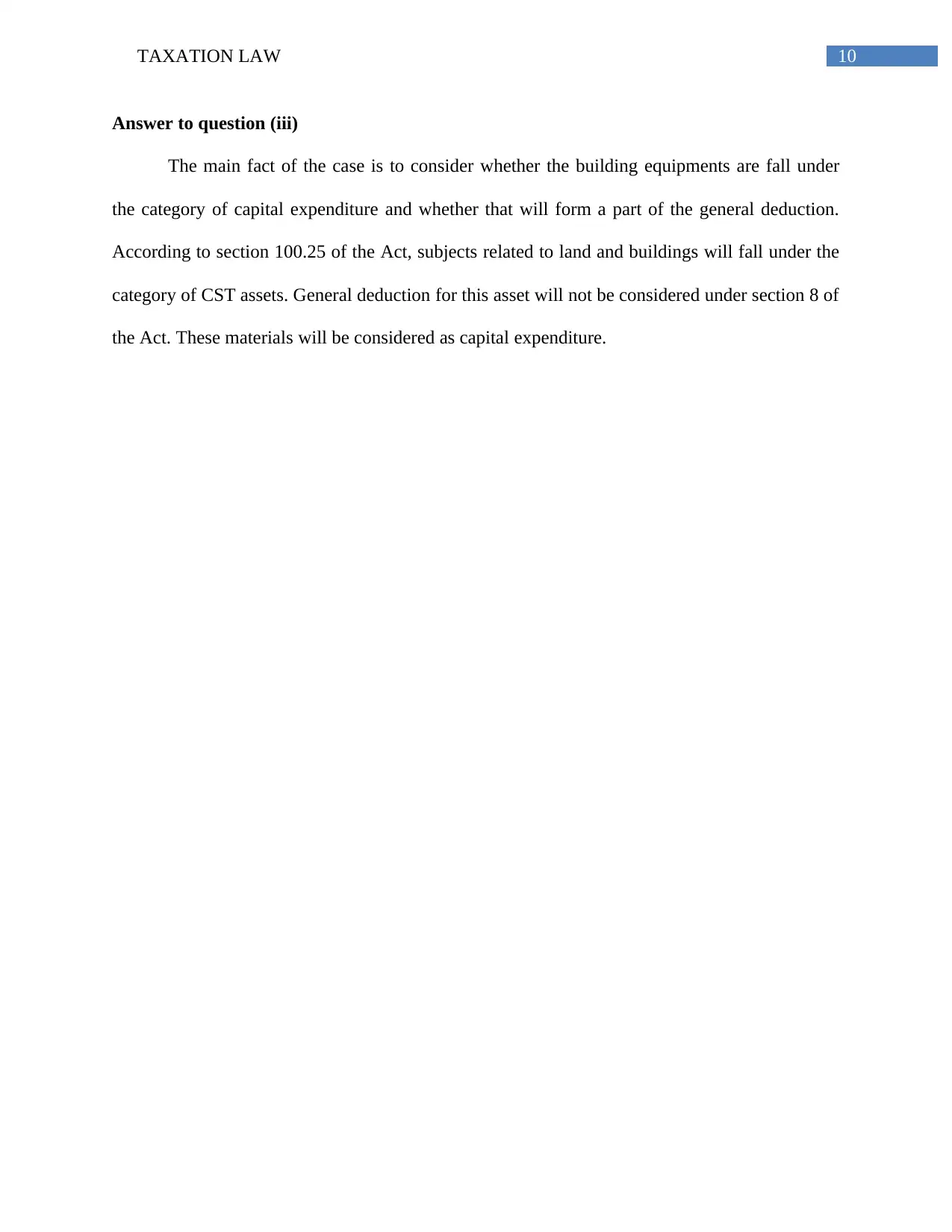
10TAXATION LAW
Answer to question (iii)
The main fact of the case is to consider whether the building equipments are fall under
the category of capital expenditure and whether that will form a part of the general deduction.
According to section 100.25 of the Act, subjects related to land and buildings will fall under the
category of CST assets. General deduction for this asset will not be considered under section 8 of
the Act. These materials will be considered as capital expenditure.
Answer to question (iii)
The main fact of the case is to consider whether the building equipments are fall under
the category of capital expenditure and whether that will form a part of the general deduction.
According to section 100.25 of the Act, subjects related to land and buildings will fall under the
category of CST assets. General deduction for this asset will not be considered under section 8 of
the Act. These materials will be considered as capital expenditure.
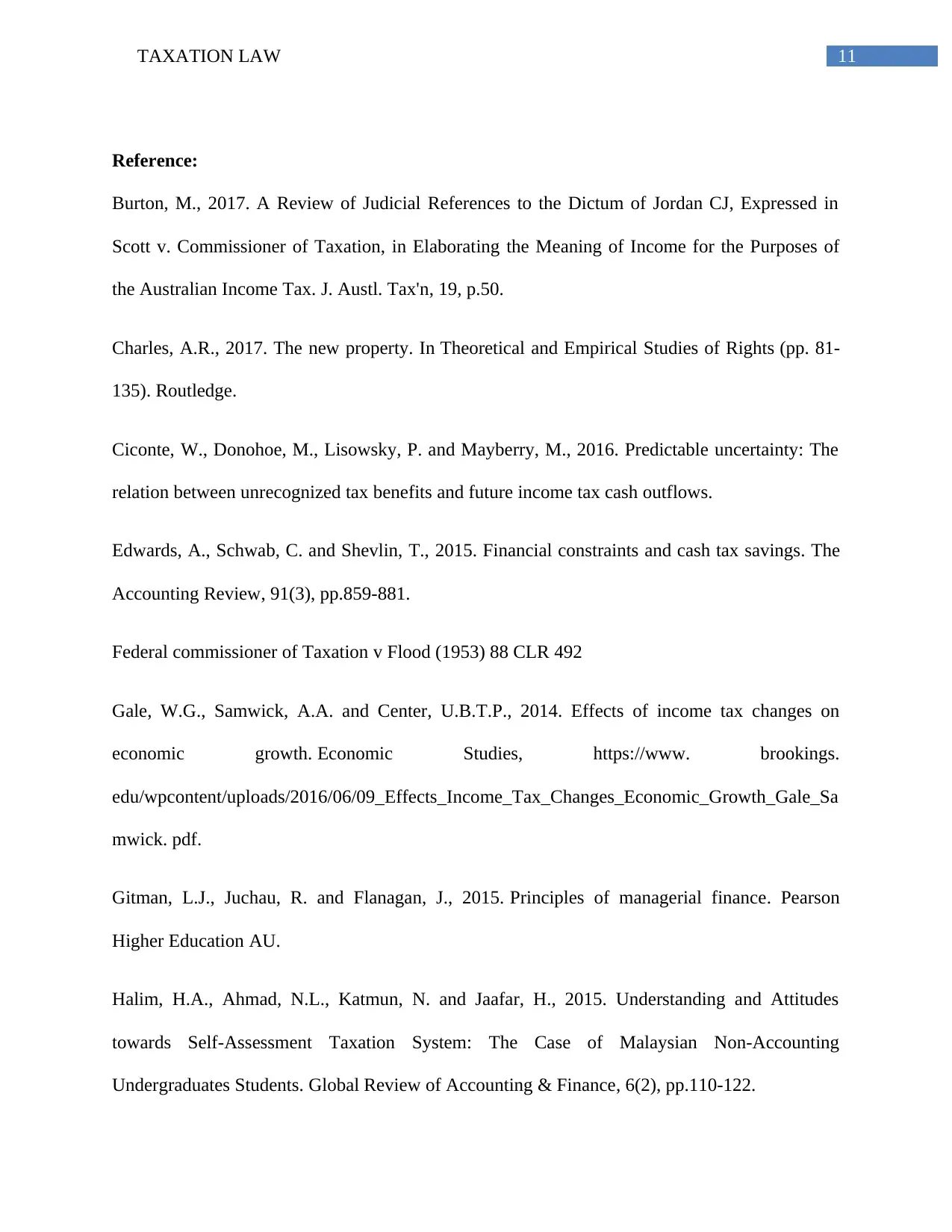
11TAXATION LAW
Reference:
Burton, M., 2017. A Review of Judicial References to the Dictum of Jordan CJ, Expressed in
Scott v. Commissioner of Taxation, in Elaborating the Meaning of Income for the Purposes of
the Australian Income Tax. J. Austl. Tax'n, 19, p.50.
Charles, A.R., 2017. The new property. In Theoretical and Empirical Studies of Rights (pp. 81-
135). Routledge.
Ciconte, W., Donohoe, M., Lisowsky, P. and Mayberry, M., 2016. Predictable uncertainty: The
relation between unrecognized tax benefits and future income tax cash outflows.
Edwards, A., Schwab, C. and Shevlin, T., 2015. Financial constraints and cash tax savings. The
Accounting Review, 91(3), pp.859-881.
Federal commissioner of Taxation v Flood (1953) 88 CLR 492
Gale, W.G., Samwick, A.A. and Center, U.B.T.P., 2014. Effects of income tax changes on
economic growth. Economic Studies, https://www. brookings.
edu/wpcontent/uploads/2016/06/09_Effects_Income_Tax_Changes_Economic_Growth_Gale_Sa
mwick. pdf.
Gitman, L.J., Juchau, R. and Flanagan, J., 2015. Principles of managerial finance. Pearson
Higher Education AU.
Halim, H.A., Ahmad, N.L., Katmun, N. and Jaafar, H., 2015. Understanding and Attitudes
towards Self-Assessment Taxation System: The Case of Malaysian Non-Accounting
Undergraduates Students. Global Review of Accounting & Finance, 6(2), pp.110-122.
Reference:
Burton, M., 2017. A Review of Judicial References to the Dictum of Jordan CJ, Expressed in
Scott v. Commissioner of Taxation, in Elaborating the Meaning of Income for the Purposes of
the Australian Income Tax. J. Austl. Tax'n, 19, p.50.
Charles, A.R., 2017. The new property. In Theoretical and Empirical Studies of Rights (pp. 81-
135). Routledge.
Ciconte, W., Donohoe, M., Lisowsky, P. and Mayberry, M., 2016. Predictable uncertainty: The
relation between unrecognized tax benefits and future income tax cash outflows.
Edwards, A., Schwab, C. and Shevlin, T., 2015. Financial constraints and cash tax savings. The
Accounting Review, 91(3), pp.859-881.
Federal commissioner of Taxation v Flood (1953) 88 CLR 492
Gale, W.G., Samwick, A.A. and Center, U.B.T.P., 2014. Effects of income tax changes on
economic growth. Economic Studies, https://www. brookings.
edu/wpcontent/uploads/2016/06/09_Effects_Income_Tax_Changes_Economic_Growth_Gale_Sa
mwick. pdf.
Gitman, L.J., Juchau, R. and Flanagan, J., 2015. Principles of managerial finance. Pearson
Higher Education AU.
Halim, H.A., Ahmad, N.L., Katmun, N. and Jaafar, H., 2015. Understanding and Attitudes
towards Self-Assessment Taxation System: The Case of Malaysian Non-Accounting
Undergraduates Students. Global Review of Accounting & Finance, 6(2), pp.110-122.
⊘ This is a preview!⊘
Do you want full access?
Subscribe today to unlock all pages.

Trusted by 1+ million students worldwide
1 out of 14
Related Documents
Your All-in-One AI-Powered Toolkit for Academic Success.
+13062052269
info@desklib.com
Available 24*7 on WhatsApp / Email
![[object Object]](/_next/static/media/star-bottom.7253800d.svg)
Unlock your academic potential
Copyright © 2020–2025 A2Z Services. All Rights Reserved. Developed and managed by ZUCOL.




